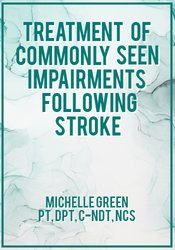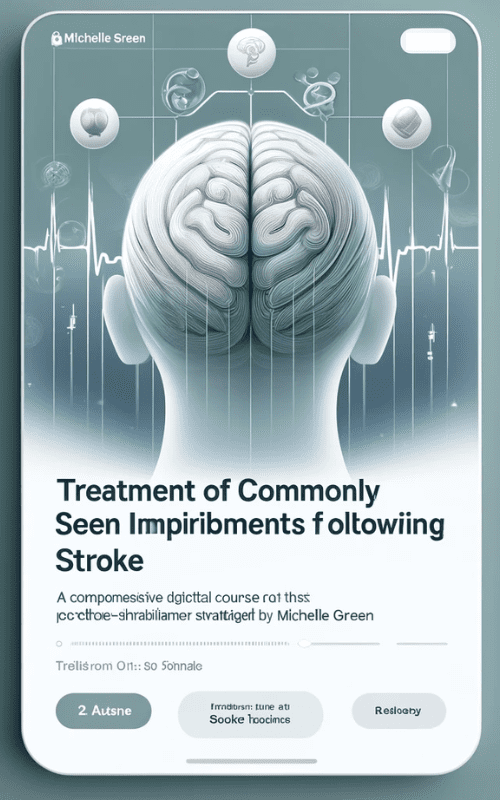Treatment of Commonly Seen Impairments Following Stroke – Michelle Green
Treatment of Commonly Seen Impairments Following Stroke – Michelle Green has the same quality as the author’s salapage.
Overview
Salepage check: Treatment of Commonly Seen Impairments Following Stroke
Author: Michelle Green
- Faculty:
- Michelle Green
- Duration:
- 2 Hours 8 Minutes
- Format:
- Audio and Video
- Copyright:
- Mar 01, 2017
Description
Stroke is the leading cause of disability in America. Therapists play a vital role in reducing, or even eliminating, disability resulting from stroke. However, therapists are increasingly pressured to produce better outcomes in a shorter period of time, often with less staff support. The results are generic treatment plans, traditional supine therapeutic exercise prescription, and range of motion or seated group activities. All of these fail to address the impairments keeping the patient from having success in functional life activities.
To reduce disability, therapists must be able to improve functional mobility in activities of daily living such as transferring, walking, dressing, and bathing through better assessment and treatment planning. For maximal recovery in stroke patients, you must be able to accurately determine each patient’s specific impairments that are limiting function. From this, you can develop precise, customized treatment plans that prioritize the impairments and reduce disability quickly and effectively.
In this one time series, you will expand your intervention “toolbox” by learning to create effective treatments that directly reduce functional limitations for any level of stroke patient, from acute care to community re-entry. This is accomplished without expensive equipment, time-consuming protocols, or labor-intensive techniques. Normal movement requirements are reviewed, which better equip you to efficiently and accurately identify the impairments that are causing dysfunction.
Treatment interventions are developed based on motor control and learning principles aimed at integrating cognition, motor ability, and the environment for maximal carryover to functional task performance. An extensive review of treatments to reduce commonly seen impairments is accomplished through by viewing exercises (you can do yourself at home or in the clinic!), demonstration, and video analysis.
Handouts
| Manual – Treatment of Impairments (10.30 MB) | 54 Pages | Available after Purchase |
Outline
Hemiplegic Upper Extremity
Poor Anterior Weight Translation (Retropulsion)
Limited Gluteus Maximus/Medius Recruitment/Sustained Contractions
Limited Quadriceps Recruitment/Sustained Contractions
Limited Proximal Postural Control
Ineffective Lateral Weight Shifts
Faculty

Michelle Green, PT, DPT, C-NDT, NCS Related seminars and products: 7
Michelle Green, PT, DPT, C-NDT, NCS, is an expert in stroke rehabilitation, with over 20 years of experience helping countless patients recover from neurological conditions. Her background in NDT, Pilates, and yoga has influenced her assessment and treatment approach, providing her with enhanced insight into movement assessment and guided movement re-education.
Dr. Green travels nationally to present seminars on stroke rehabilitation, and she is known for her dynamic, hands-on teaching style. She earned her Doctorate in Physical Therapy from University of North Carolina Chapel Hill, and she teaches as an assistant professor in the DPT program at Campbell University. Her additional interests include education and learning, impairment-based treatment across the lifespan, and application of mind-body practices for improving mental and physical health.
Speaker Disclosures:
Financial: Michelle Green is an assistant professor at Campbell University. She receives a speaking honorarium from PESI, Inc.
Non-financial: Michelle Green is a member of the American Physical Therapy Association; and the North Carolina Physical Therapy Association.
Curriculum
FAQs
Requirements
- A stable internet connection to access the digital course materials.
- Basic knowledge or interest in stroke rehabilitation and treatment techniques.
- Access to a device compatible with video playback, such as a computer, tablet, or smartphone.
- A desire to expand skills in post-stroke patient care and rehabilitation.
Features
- Comprehensive Modules: Step-by-step guidance on identifying and treating common impairments post-stroke.
- Expert Insights: Gain knowledge from Michelle Green, a specialist in stroke rehabilitation.
- Practical Strategies: Hands-on approaches for real-world application in therapy sessions.
- Digital Access: Study at your convenience with flexible, on-demand access to course content.
- Affordable Pricing: Save up to 80% compared to the original sale page price.
- Supportive Resources: Downloadable materials and tools for enhanced learning.
Target audiences
- Healthcare Professionals: Therapists, physiotherapists, and medical practitioners focused on neurological and post-stroke care.
- Caregivers and Families: Individuals supporting loved ones in post-stroke recovery.
- Students: Medical and therapy students interested in specializing in neurological or rehabilitative care.
- Rehabilitation Centers: Teams looking to enhance their approach to treating stroke-related impairments.


